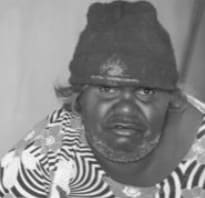Tracey Simms Australian, Pitjantjatjara, b. 1965
Tracey Simms mother, Ngalpingka Simms, was living at Warburton Mission with her husband, who was working on the copper mine on the outskirts of the mission, when she made the long trek to Leonora Hospital, north of Kalgoorlie, to give birth to Tracey. Ngalpingka became very ill after the birth and Tracey was fostered out for her first years with a family living in Perth and consequently started her life with English as her first language. She returned before primary school and grew into a young girl at Warburton Mission before a ending High School in Esperance whilst boarding at the nearby Fairhaven Mission. She has fond memories of these times spent with other Indigenous girls from throughout the Western and Central Desert regions, as this was one of the few educational resources available at the time. After high school Tracey married young and had one child, a son, who now has children of his own. Tracey tells of her father and grandfather being hard workers and respected by Mission staff, enough that they were the two who were sent to search for the last Ngaanyatjarra family group to have contact with the western world. This was the Ward family who were kin of Traceys and she says her father and grandfather located the family at the site of Tika-Tika in the Gibson Desert region and her mother’s country. The family were escorted in but were immediately asked by film makers associated with the Western Australian Museum to return to their way of life for the purpose of documentation. The consequent film has become a national treasure. Traceys husband died in a road accident early into her marriage, she also lost her father around this time. Tracey later remarried and resided in Irruntytju Community before losing her second husband, this culturally prompted her to make the move to Tjuntjuntjara. Tracey is now employed with Spinifex Arts Project as a translator among other duties and is also an artist in her own right.
